Direct aqueous analysis of pesticides and PPCPs in drinking and bottled water at parts per trillion levels
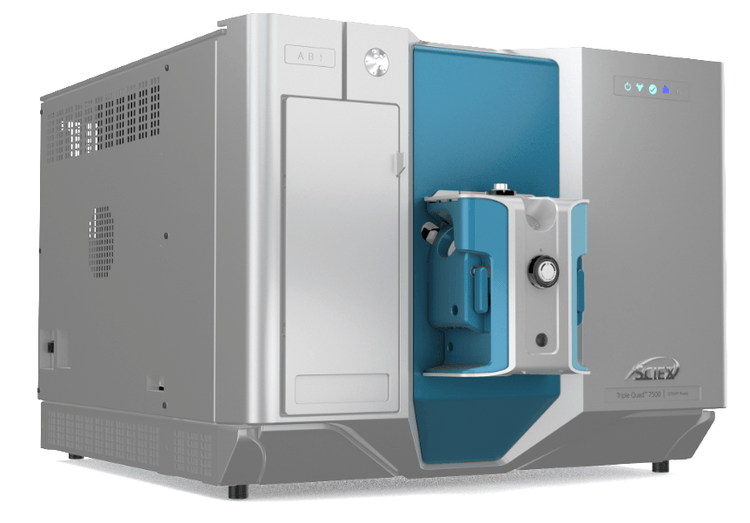
Abstract
Using a direct aqueous injection approach, the SCIEX 7500 system provided low-level quantification across a large suite of 431 determinands in water samples, achieving parts-per-trillion detection limits. The ease of processing and flexibility of SCIEX OS software reduced the time between sampling and reporting results, key for labs that monitor the health and purity of the water network.
Introduction
Drinking water analysis is subjected to extremely low and rigid prescribed consent values (PCV) for determinands. Water suppliers and utility companies need to ensure that the final water product they send out for bottling or into supply networks is safe and complies with state and country regulations.1,2,3 Water can be a challenging matrix, in particular if it is sourced from a river, lake or reservoir before entering the water treatment process. The laboratories which serve the water companies must have highly sensitive instrumentation to quantify beyond PCV limits with precision and confidence and also handle all the matrix challenges.
Here, a series of experiments was conducted in collaboration with Vitens Water Company, to test several types of water samples spiked with a mixed standard of 431 determinands, including pesticides, pharmaceuticals and personal care products. This work explores the sensitivity levels of the SCIEX Triple Quad 7500 system, the reproducibility of the acquired data as well as the simplicity of data processing using SCIEX OS software.
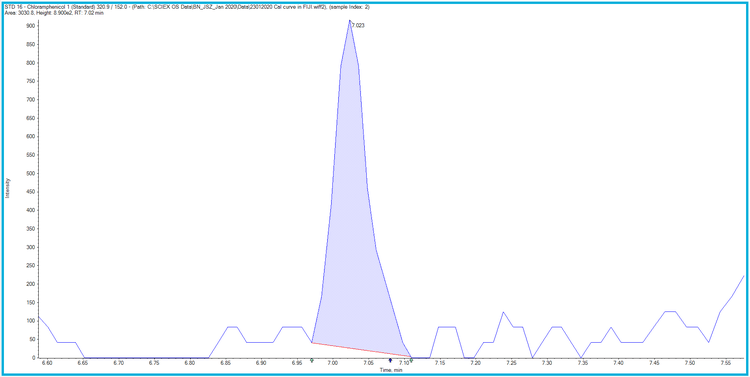
Key features of the SCIEX 7500 system for drinking water analysis
- Very high sensitivity demonstrated using the SCIEX 7500 system for sub part per trillion detection limits for analytes in drinking water
- Includes improvements in the generation of ions with the OptiFlow Pro ion source and the E Lens probe and the capture of ions with the D Jet ion guide18
- Very simple sample preparation strategy of direct aqueous injection greatly streamlines the water analysis workflow
- SCIEX OS software is a single platform for data acquisition, data processing and streamlined results review
- Ability to upgrade to a QTRAP system future proofs the lab with an easy upgrade path to obtain the qualitative functionality of the linear ion trap scan features in addition to the quantitative triple quadrupole functionality
Methods
Sample preparation: Direct aqueous injection of spiked water samples - MilliQ water, tap water (SCIEX Concord Laboratory), Evian bottled water and Fiji bottled water. The samples were spiked with a custom mix standard provided by Vitens, Netherlands, containing 431 analytes, include 46 internal standards. A series of 12 standards were made in the respective matrices at sequential concentrations from 0.1 to 500 ng/L. A collection of unknown blank samples was also included in this study.
Liquid chromatography: HPLC separation was performed on an ExionLC system using a Phenomenex Luna Omega C18 column (100 Å, 1.6 µm, 100 x 2.1 mm P/N 00F-4742-AN). The gradient used for the separation is outlined in Table 1. The column oven temperature was set to 40°C. For this experiment, the selected injection volume was 500 µL.
Mass spectrometry: The SCIEX Triple Quad 7500 system was equipped with the OptiFlow Pro ion source and operated in conventional high flow ESI mode. To increase the efficiency in the transfer of the sample into the mass spectrometer, the E Lens probe was also used. Due to the nature of this acquisition method, the system was configured for positive and negative analysis with a fast polarity switching time of five milliseconds (ms).
The acquisition method with 431 determinands was created in SCIEX OS software, using the Scheduled MRM algorithm to maximize the number of analytes in a single injection. Each determinand had two MRM transitions. Standards and spiked samples were injected multiple times to conduct a reproducibility and accuracy study.
Data analysis: The Explorer and Analytics tools in SCIEX OS software were used to review the acquired sample data.
Identification and integration of the peaks were achieved with the Auto Peak algorithm. Improvements in the recognition and baseline integration of peaks expedited data review and reduced the need for manual adjustments.
Method development and optimization
A custom mix of 431 pesticides, pharmaceuticals and personal care products in acetonitrile was prepared by Vitens water laboratory to prepare a sequential series of calibration standards in MilliQ water. The calibration standard concentrations were 0.1, 0.2, 0.5, 1, 2, 5, 10, 20, 50, 100, 200 and 500 ng/L. A calibration blank was also prepared.
Store-bought bottles of Fiji Water, Evian Water and tap water from SCIEX Concord Laboratory were spiked with varying concentrations within the calibration range of 0.1 to 500 ng/L. Chromatography gradients and conditions along the SCIEX 7500 system were optimized to enable adequate data points across all peaks (Table 1 and 2).
Due to the broad range of compounds analyzed in this study, polarity switching was used to maximize compound coverage. The speed of polarity switching ensured that very good peak sampling was obtained for all analytes, with sufficient data points across the LC peak (Figure 2, 50 ng/L). The two fungicides shown in the positive mode are carbendazim and cyprodinil. Carbendazim4 is a benzimidazole fungicide used across fruit, vegetable and cereals. Cyprodinil5 is for the treatment of rhynchosporium outbreaks on crops. Atrazine6 is a weed killer that has been used in corn farming.
Negative mode compounds perfluorooctanoic acid (PFOA) and perfluorooctanesulfonic acid (PFOS) are perfluoroalkyl and polyfluoroalkyl substances (PFAS).7 These compounds are used in industrial applications such as cookware manufacturing, the upholstery industry and firefighting. The fungicide fluazinam8, used in the farming of potatoes, peanuts and grapevines, was also selected.
Very good chromatographic separation was observed (Figure 3), which also helps ensure good quantitative coverage.

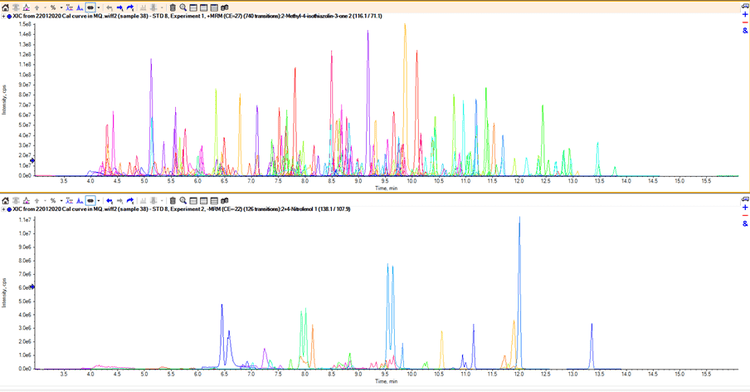
Calibration curves
A series of calibration curves were prepared in MilliQ water to evaluate the sensitivity of the SCIEX 7500 system and determine the lower limits of quantification. To enable maximum coverage of analytes in the samples, a calibration range from 0.1 ng/L to 500ng/L was spiked into MilliQ water. Using SCIEX OS software for data processing, calibration curves were quickly generated and supporting statistical data was summarized for quick review (Figures 4 and 5). The ion ratio confidence column shows that all concentrations passed, with no non-conforming ratios flagged. Strong linearity was observed for most compounds. Furthermore, SCIEX OS software will also flag any erroneous calibrators and automatically remove the standards for regression.
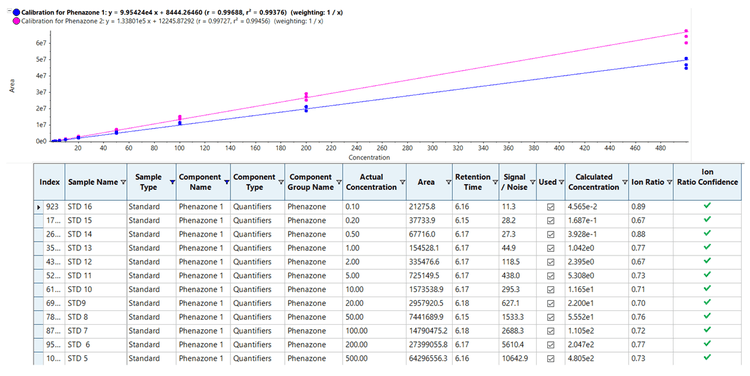
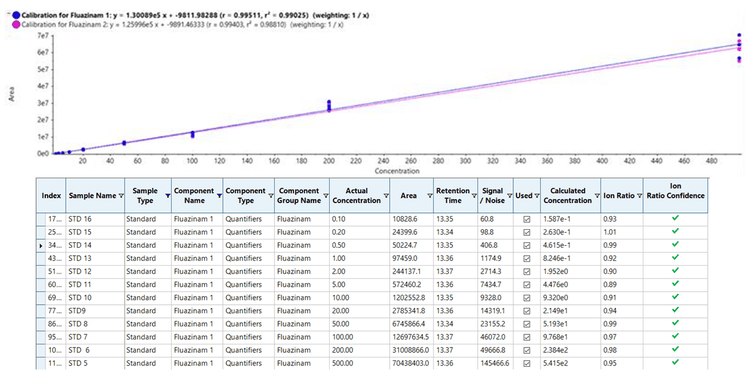
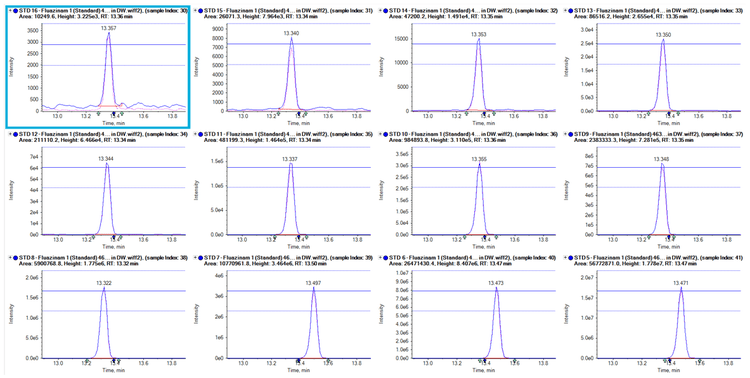
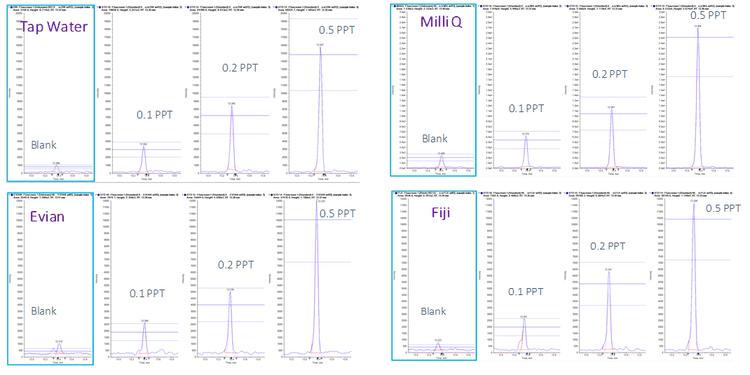
A new era of sensitivity
Very good sensitivity was observed across the series of experiments conducted in this study. Using the SCIEX 7500 system, which includes improvements in both ion generation and ion sampling, detection limits of 0.1 ng/L were achieved for many of the analytes. Figure 8 shows the data for bottled water spiked with very low levels of concentrations of six different compounds compared with blank bottled water. All data were acquired through direct aqueous injection.
Figure 8 demonstrates sub-part per trillion limits of detection with direct aqueous injection. Directly testing a water sample reduces the costs and time demands associated with having to perform more laborious sample preparation approaches such as concentrating the sample with solid phase extraction (SPE). Furthermore, by removing the sample preparation step, there is a reduced risk of cross-contamination, leading to false-positive results.
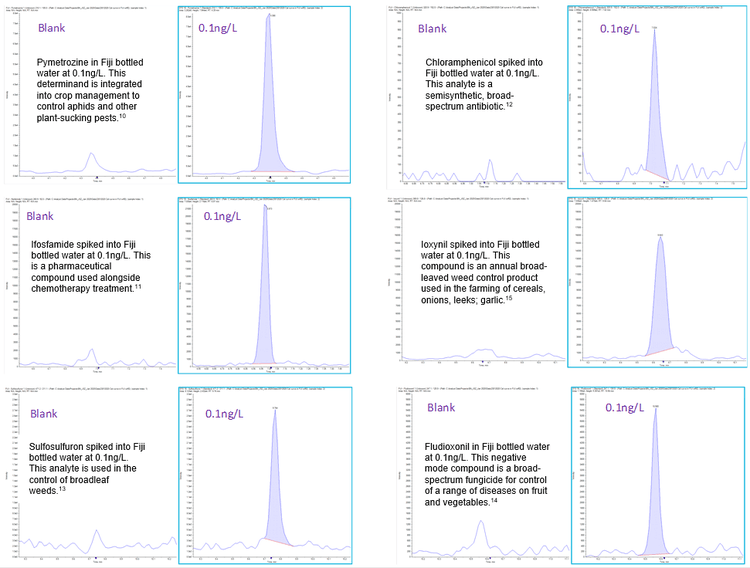
Dicamba analysis
One of the more problematic determinands to analyze is dicamba. This herbicide is used in the commercial farming of crops and grains, its purpose is to kill perennial broadleaf weeds. Dicamba is applied to control brush and bracken in grazing pastures as well as legumes and cacti.17 Dicamba has been found to be highly soluble in water (500 g/L) and is therefore a determinand of concern for water laboratories. Direct aqueous analysis of this analyte is sometimes problematic and reaching low-level parts per trillion detection limits is very difficult.
In this series of experiments dicamba was one of the 431 compounds in the custom mix. Here, a limit of detection (LOD) of 5 ng/L (5 ppt) was observed with one transition of the dicamba MRM transitions, and a limit of quantification (LLOQ) of 10 ng/L (10 ppt) was obtained with 2 transitions with correct ion ratio was achieved. Figure 9 shows the chromatograms for dicamba spiked into MilliQ water at 50 ppt down to 5 ppt. The acquired peaks clearly display the confirmatory ion ratios between the two transitions for confident reporting of results.
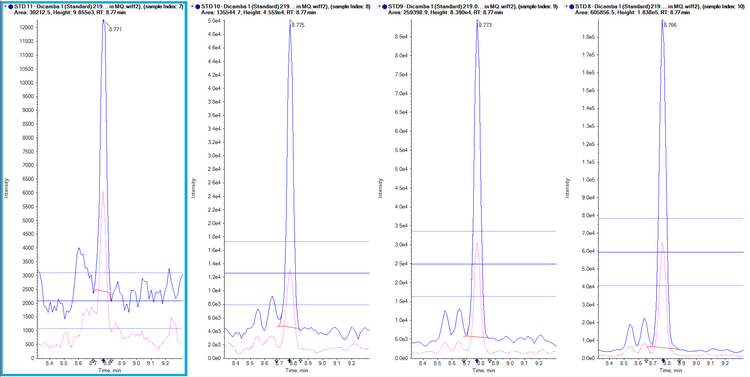
Reproducible results
The ability to quantify to a low-level concentration is important, but the ability to consistently deliver this high-quality data time and time again is crucial. Figure 10 provides an example of the reproducibility of a determinand (phenazone) at low levels of concentration, which has been spiked into the sample. Even at the lowest concentrations at a sub-part per trillion, the percentage coefficient variation (%CV) is consistently low and shows a high degree of accuracy and precision. At the LOD for phenazone, the %CV is 6.76% in this example.

Conclusions
In this work, the SCIEX 7500 system has demonstrated its potential for low-level quantification (parts per trillion detection limits) across a relatively large suite of 431 determinands. The ability to analyze this many compounds without the need for laborious sample preparation improves operational efficiencies. The direct aqueous injection approach enables water testing laboratories to go beyond their current limits of sensitivity. Combined with the ease of processing and flexibility of SCIEX OS software, the time between sampling and reporting results was expedited through this workflow which can positively impact how the data produced by the labs that monitor the health and purity of the water network.
There is scope to expand the number of analytes tested and apply this system to other individual workflows which demand very low limits of quantification. The innovations of the SCIEX 7500 system can open the water industry up to an era of analysis where the impacts of the matrix studied is reduced while the levels of sensitivity are increased.
References
- Council Directive 98/83/EC of 3 November 1998 on the quality of water intended for human consumption
- Safe Drinking Water Act (SDWA)
- The Water Supply (Water Quality) Regulations 2018
- Carbendazim - University of Hertfordshire - Pesticide Properties DataBase
- Cyprodinil - University of Hertfordshire - Pesticide Properties DataBase
- Atrazine - University of Hertfordshire - Pesticide Properties DataBase
- Analysis of EPA Method 537 per- and polyfluoroalkyl substances (PFASs) using microflow liquid chromatography SCIEX technical note RUO-MKT-02-11534-A.
- Fluazinam - University of Hertfordshire - Pesticide Properties DataBase
- Phenazone - National Library of Medicine - National Center for Biotechnology Information
- Pymetrozine - University of Hertfordshire - Pesticide Properties DataBase
- Cybutryne - National Library of Medicine - National Center for Biotechnology Information
- Ifosfamide - National Library of Medicine - National Center for Biotechnology Information
- Chloramphenicol - National Library of Medicine - National Center for Biotechnology Information
- Sulfosulfuron - University of Hertfordshire - Pesticide Properties DataBase
- Fludioxonil - University of Hertfordshire - Pesticide Properties DataBase
- Ioxynil - University of Hertfordshire - Pesticide Properties DataBase
- Dicamba - University of Hertfordshire - Pesticide Properties DataBase
- Enabling new levels of quantification. SCIEX technical note RUO-MKT-02-11886-A.
Acknowledgements
Vitens is a drinking water company based in the Netherlands that wants water to work for people. They try to achieve this by providing outstanding service, useful products and services, and reliable information. The state-of-the-art Vitens laboratory in Leeuwarden carefully monitors the quality of drinking water from the source to their customers. Every day, the laboratory processes hundreds of samples and the analyses are largely automated. Its logistics resources and advanced measuring equipment ensure that high efficiency and high-quality data is generated. The laboratory has implemented a quality management system in compliance with ISO/IEC 17025.

